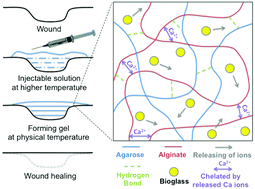Design of a thermosensitive bioglass/agarose–alginate composite hydrogel for chronic wound healing†
Abstract
Chronic wounds are a major health problem around the world, and there is a need to develop new types of dressing materials to enhance chronic wound healing. Humidity and angiogenic conditions are two important factors that may significantly affect the healing process. Therefore, a new wound dressing system based on bioglass (BG) and agarose–alginate (AA) has been designed, which can create a moist environment and improve the angiogenic condition of the wound area at the same time. The obtained BG/AA hydrogel has thermosensitivity allowing it to gel at physiological temperature through the interaction between the agarose and alginate polymer chains, and the chains can be further cross-linked by ions released from BG. The BG/AA hydrogel can promote migration of fibroblast and endothelial cells and it can also enhance the angiogenesis of endothelial cells in a fibroblast-endothelial cell co-culture model in vitro. The potential of the BG/AA hydrogel as a wound dressing has been further evaluated by using the rabbit ear ischemic wound model. The results demonstrate that the BG/AA hydrogel can enhance blood vessel and epithelium formation, which contribute to wound healing. The present study suggests that this new BG/AA hydrogel system may be used as a bioactive dressing for chronic wound healing.


 Please wait while we load your content...
Please wait while we load your content...